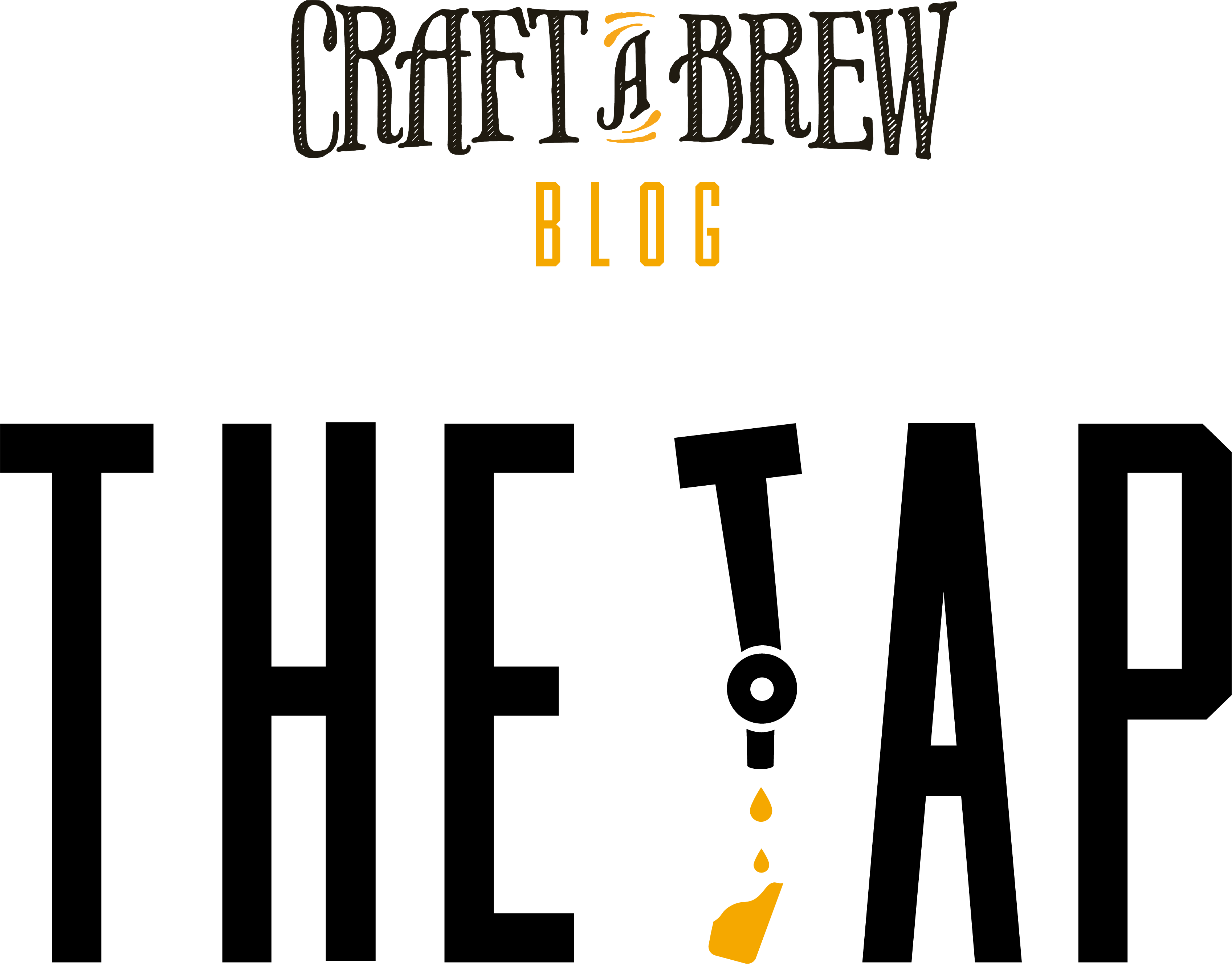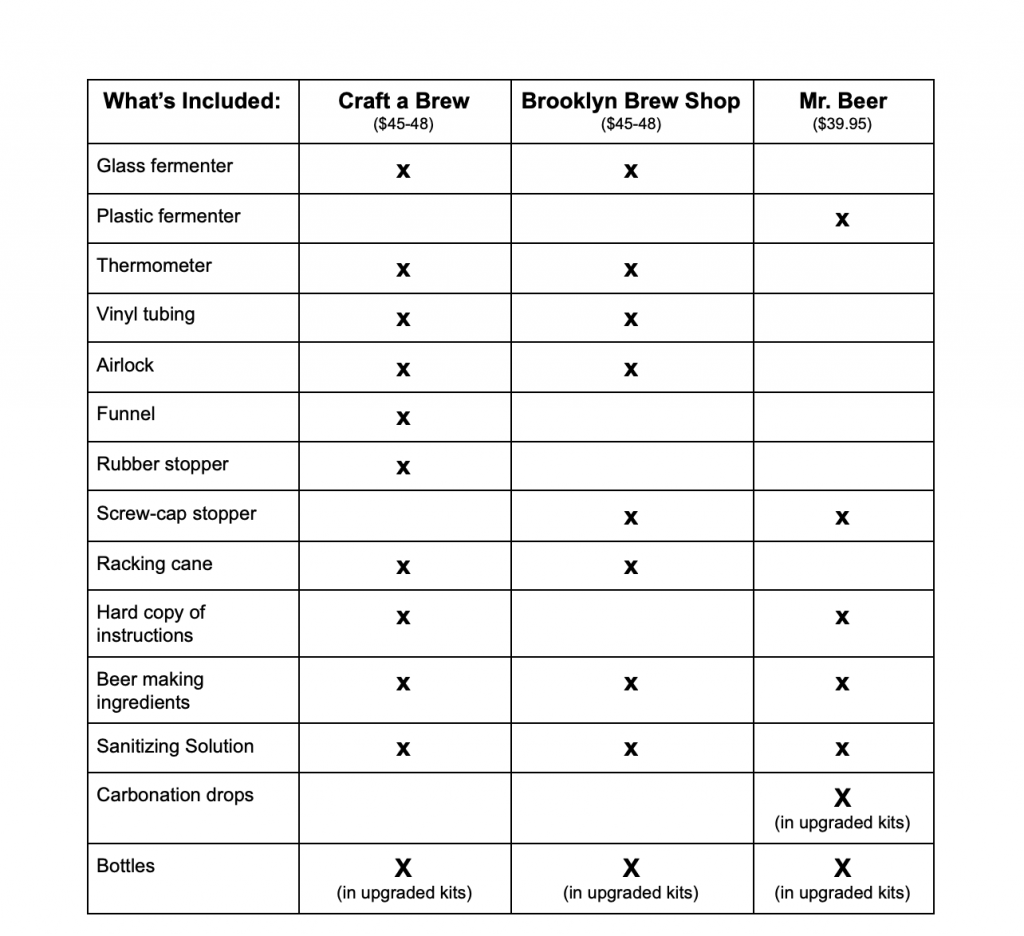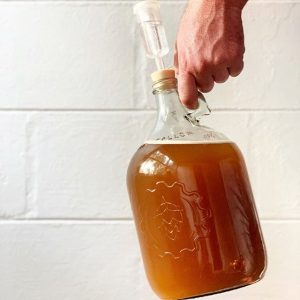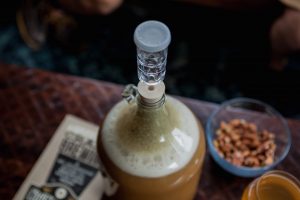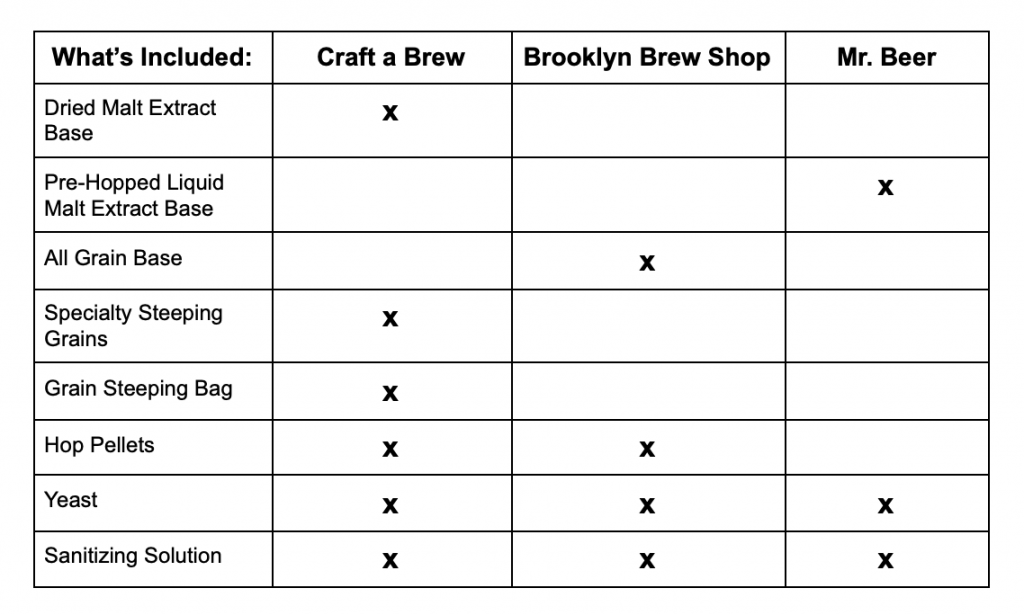
22 Mar Which home brew kit is the best for beginners
It’s a tale as old as time. A craft beer drinker finally decides that it’s time to start brewing their own liquid gold. You’re excited to learn, hands on, HOW beer is made, but where do you go from there? With so many options to choose from, which home brew kit is the best for new brewers?
In this post we’ll review some of the top brew kit brands – Craft a Brew, Mr. Beer and Brooklyn Brew Shop – analyzing what’s included in each kit, weighing the pros & cons, reviewing the quality of materials & ingredients and more to determine which home brew kit is the best for you.
Before we get into the specifics, there are a few things that every beginner needs to consider before diving head first into their new hobby:
-
- How much time can you devote to your new hobby? Some beer kits allow you to knock out a brew day in under an hour, while others will take several hours. Every home brewed beer averages 4 weeks from start to finish – this process involves a brew day, 2 weeks of fermentation, a bottling day and 2 weeks to carbonate in bottles. Your schedule may help determine which home brew kit is the best for you.
-
- How much do you want to spend? Most 1 – 2 gallon brew kits will clock in under $50, though some will be pricier and some will be a major bargain. Generally, you get what you pay for, as cheaper kits include cheaper materials and ingredients that can translate in your finished beer. Depending on your budget you may want to spend a little extra to get the full experience & the best tasting home brewed beer.
-
- How much do you want to learn about brewing? Some beer kits do some (or most) of the work for you before you even open the box with pre-processed ingredients, while other kits will have you perform every single step of the homebrewing process. Which home brew kit is the best choice for you will depend on your curiosity level & your time commitment!
With those considerations in mind, read on to see how the top beer kits stack up against each other. Each kit is quite different, using different variations and combinations of basic homebrewing equipment and ingredients. Let’s get into it!
Which home brew kit is the best for you? Equipment considerations.
Fermenter
The vessel that your beer ferments in is an essential component of any beer brewing kit. A good quality fermenter is important for crafting the best possible beer at home. The fermenter is where the yeast gets to work converting sugars into alcohol, turning all those ingredients into beer. There are a variety of fermenters that brewers use, ranging in size, material and shape.
Glass Carboy
Craft a Brew and Brooklyn Brew Shop both use a classic 1 gallon glass carboy (jug), while Craft a Brew’s fermenter does feature a hop design. Glass is a tried and true material for fermentation for many reasons, but does have some drawbacks:
-
- It is impermeable to oxygen (your biggest threat during fermentation).
-
- It’s durable enough to sanitize & scrub clean between batches without scratching.
-
- Clear glass gives you a front row seat to fermentation. It’s fascinating to watch the yeast flury and dance in your beer. Plus, you can observe the color and clarity changes in your beer.
-
- The transparency of glass also means you may need to protect your beer from sunlight by covering with a towel, box, etc. or you’ll need to ferment in a dark area to prevent light-strike (which can cause off-flavors in your beer).
-
- Glass is delicate – so you will need to exercise more care in handling.
Plastic Fermenter
Mr. Beer homebrew kits use a proprietary 2 gallon plastic fermenter shaped like a keg, which also features a spigot for bottling your beer. This eliminates the need for siphon transfers, which is a plus, but plastic also has quite a few cons to consider:
-
- Plastic is lightweight, making storage & handling easy.
-
- Most plastic fermenters feature a wide opening, which makes cleaning and sanitizing easier.
-
- Plastic is much more susceptible to scratching. Scratches can quickly lead to contamination, as these small abrasions are prone to harboring bacteria.
-
- Most plastic fermenters are also opaque, like Mr. Beer’s brown keg or classic white bucket fermenters, which means you can’t observe the fermentation inside.
-
- Lastly, plastic is more permeable to oxygen, which should be avoided at all costs during fermentation. Oxidized beer can be dull in color & flavor, often tasting like cardboard in your glass.
Airlock
Craft a Brew & Brooklyn Brew Shop’s carboy fermenters utilize an airlock – a tool that allows the CO2 created during fermentation to safely escape the carboy without letting oxygen inside. Airlocks (also called bubblers) are filled with water to provide a barrier through which CO2 can escape, but oxygen can’t penetrate. The bubbling sound is a helpful indicator that the fermentation is active & the yeast are hard at work. Generally, when bubbling in the airlock has ceased it means the beer is ready to bottle.
Mr. Beer plastic fermenters include a vented screw-top lid to allow CO2 to escape. The dark brown fermenter and lack of a bubbler can make it trickier to monitor your homebrew’s progress.
Beer Bottles
Craft a Brew, Mr. Beer and Brooklyn Brew shop each offer homebrew kits that include bottles and those that do not. Bottling is a crucial part of the homebrewing process, but you may or may not need a kit that includes bottles and caps.
You can repurpose bottles from store bought beer – as long as they are pry-off bottles. This is a great way to save money on bottles & reduce waste. You’ll just need to source a bottle capping tool & crown bottle caps. Both Craft a Brew & Brooklyn Brew Shop offer bottle capper & cap sets for recycled pry-off bottles.
If you’d prefer to stock up on fresh bottles Craft a Brew & Brooklyn Brew Shop offer standard 12 oz beer bottles that use pry-off caps. Mr. Beer offers 740 mL plastic bottles with reusable screw top caps.
You can also source swing-top bottles (like Grolsch brand beer) to carbonate your beer. This bottle style is a great option if you’d like to use less equipment & accessories because they don’t require disposable bottle caps or a capping tool.
Which home brew kit is the best for you? Ingredient considerations.
Quite possibly THE greatest differences between these three beer brewing kit brands lie in the ingredients. While all beer is made using water, barley, hops & yeast, the quality, presentation & techniques can vary dramatically. Which home brew kit is the best one for you? It may very well come down to the ingredients.
Base Malts
Base malts provide the main source of fermentable sugars in any homebrewed beer. Yeast convert these sugars into alcohol during fermentation. Every home brew kit will include base malts, but they can come in many forms including Extract (Dry or Liquid) or All-Grain. Let’s review the differences to determine which home brew kit is the best option for you.
Extract vs. All-grain
The simplest way to explain the difference between using malt extract or all grain is to think of brewing beer like making lasagna. You can make your noodles from scratch before baking your dish OR you can use store bought lasagna noodles. The noodles are made with the same ingredients (eggs & flour), but a box of noodles saves you a lot of time when making the dish at home. Think of malt extract like using a box of pasta, and all grain like making pasta from scratch.
An all-grain beer kit, like Brooklyn Brew Shop, requires the homebrewer to extract sugars from malted barley. This is done by milling, mashing & sparging the grains to create wort (unfermented beer).
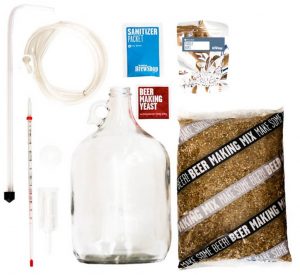
-
- All grain really helps you learn about the beer making process!
-
- The all-grain brewing process is much more time intensive and can take 3+ hours. It also requires additional tools: multiple pots & a strainer.
-
- Because you’re tasked with extracting the sugars from your grains there is more opportunity for error and missing the target gravity (sugar content). Small fluctuations in temperature can result in major changes to the finished beer’s flavor.
An extract brew kit – like Craft a Brew or Mr. Beer – includes packaged dehydrated wort, which is prepared by master maltsters so you don’t have to perform those time-consuming steps yourself on brew day. Extract ensures consistency while delivering the flavor of a perfectly executed all-grain brew.
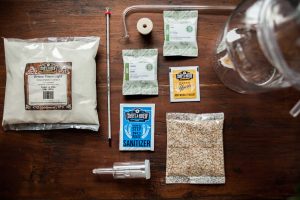
-
- A majority of homebrewers get their start with an extract kit.
- Extract significantly reduces the opportunity for error, which can impact fermentation & the finished ABV.
-
- Using extract saves a lot of time on brew day, meaning you’re only spending about 30 minutes to 1.5 hours brewing your beer – about 90 minutes less than all-grain brewing.
For more information on Extract vs. All Grain brewing, check out our blog post: “What Is An Extract Beer Kit?” Depending on your schedule and your goals as a new brewer, choosing which home brew kit is the best for you may depend on this key difference.
Dried Malt Extract vs. Liquid Malt Extract
Mr. Beer recipes feature pre-hopped Coopers liquid malt extract (LME).
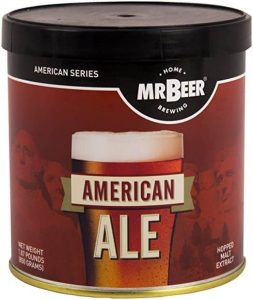
-
- It looks much like molasses and is packaged in cans that are shelf stable for several years. Unfortunately this does mean the foundation of your homebrew may have been gathering dust on a shelf for a few years before you receive it.
-
- Using LME significantly reduces your time spent brewing – you can brew a beer and fill your fermenter in about 30-45 minutes.
-
- One of the reasons brew day is so quick: LME is commonly pre-hopped. This means that instead of receiving hop pellets, the hops were already incorporated into the can of LME. This eliminates some of the fun of brew day: handling the hops, taking a big whiff and learning about the science & timing of hop additions that influence the bitterness, flavor & aroma of your beer.
Craft a Brew beer recipes feature Briess dried malt extract (DME).
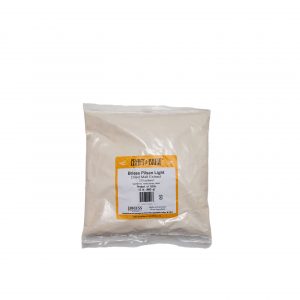
-
- It looks much like tan flour & the powdered malt base is packaged in air-tight bags.
-
- Dry malt extract is not pre-hopped, making it subtle in flavor. Which is ideal, as it serves as the main source of fermentable sugars, but allows specialty malts & hops really shine.
-
- Using DME ensures a streamlined brew day – usually clocking in at 1.5 hours.
Specialty Grains

While base malts provide the fermentable sugars, specialty grains provide the flair, flavor & color. These specialty grains are where a beer’s style really comes together.
Specialty malts include roasted malts, Munich malts, caramel malts and wheat malts. They can be chocolatey, smokey, bready, biscuity, doughy, acidic, roasty & more. A specialty grain bill can also include barley, oats, rye, corn, etc. to create a fuller body, to produce creamy or dry mouthfeel or to increase or decrease haze. Specialty grains are a source of nuance and complexity in your finished homebrew.
Each Craft a Brew beer kit includes a dried malt extract base DME plus a separate bag of specialty grains that are steeped in hot water before adding DME. The specialty grains will vary in every beer style, containing either a single variety of malt or a blend of up to 5 varieties of malts.
Mr. Beer kits do not include specialty grains, just the can of LME. The LME is essentially a beer that was previously brewed with grains and boiled down for an extended time to create an extract.
Brooklyn Brew Shop kits package the specialty grains into the bag of base malts. Your homebrew will benefit from the nuances of those specialty grains, though the all-grain brewing process can be a more challenging way to incorporate them. Small fluctuations in temperature or technique can yield in big changes in the resulting flavor.
Hops
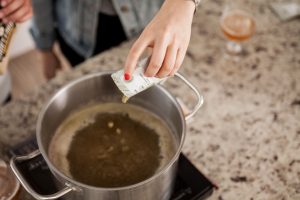
Everyone’s favorite beer ingredient often steals the show – with good reason! Hops lend balance to beer, otherwise the finished product would be overly sweet. Hops also act as a natural preservative & are most often used for their bitterness – derived from the alpha acids inside the hop cone.
While hops are responsible for the most bitter, dank, funky IPAs you’ve ever tried, they’re also the key to hazy, juicy, fruit forward and floral IPAs. It’s all in HOW you use hops on brew day.
-
- Extremely bitter beers will use most of the hops at the very beginning of the boil to extract as much of the hop oils as possible.
-
- To squeeze more flavor and aromatics from hops, they can be used late in the boil or sometimes not boiled at all. You can Dry Hop a beer by adding hops to already-fermenting beer to bypass bitterness altogether.

Craft a Brew and Brooklyn Brew Shop beer kits feature individually packaged hop pellets, which are used at various times throughout brew day to dial in the hop profile. Each kit may include multiple packets of hops used at various points in the beer making process. This is also called a “hop schedule.”
Alternatively, Mr. Beer kits feature pre-hopped LME instead of hop pellets. This means you don’t get the experience of handling hops on brew day. In determining which home brew kit is the best for your first beer making experience, you should consider how important handling hops on brew day is to you.
Beer Styles
All of these ingredients come together on brew day & during fermentation to create a particular beer style. And if you’re a craft beer lover who is considering brewing your own beer you want to make sure it’s a beer you’re going to love!
When choosing which home brew kit is the best one for you consider the range of beer styles the brand offers along with any limitations you may face when choosing the ingredients or style for your very first batch. If you’re investing in a new hobby make sure you’re going to like the beers you brew.
Craft a Brew offers 20+ beer styles, all of which are available in a homebrewing starter kit. Choose from any beer style offered on the website like a kettle sour, a chocolate milk stout, a classic brown ale or even a Stone Pale Ale collaboration. When you’re ready to brew another batch you can choose any beer recipe kit (ingredient refill) from the 20+ diverse beer styles.
Brooklyn Brew Shop offers 20+ beer styles as options for your first beer kit and 40+ beer making mixes (ingredient refills) that you can brew after that. Styles include IPAs, jalapeno saison, an oatmeal stout and brewery collaboration kits.
Mr. Beer has just 6 beer styles available in their starter kit offerings (including 2 IPAs, a Pale Ale, Golden Ale & Amber Ale). They do offer 100+ recipe refills plus a root beer ingredient kit to brew your second batch, but more limited options for your initial beer kit selection.
Which home brew kit is the best choice? Let’s Recap!
We covered a lot of ground, so let’s review what Craft a Brew, Mr. Beer & Brooklyn Brew Shop have to offer a brand new brewer by focusing on each kit’s features:
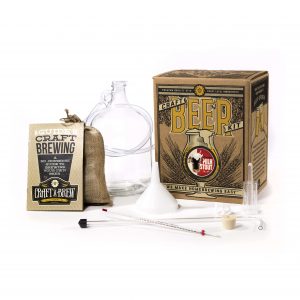
-
- Price: $45 – $48
- What’s included:
- 1 gallon glass carboy
- Funnel
- Racking cane & filter tip
- #6.5 Rubber stopper
- Transfer tubing
- Airlock
- Glass thermometer
- Guide to Craft Brewing instruction manual
- Sanitizer
- Beer Recipe Kit (ingredient kit) of choice
- Dry Malt Extract
- Specialty Steeping Grains & Steeping Bag
- Hops
- Yeast
- Sanitizer
- Special Ingredients (if applicable)
- NOT included:
- Bottles (can upgrade to a bundle or source your own)
- Features & Benefits:
- ~1.5 hour brew day
- Strikes a great balance between quality, time investment & cost
- Can choose from ANY of their 20+ beer styles for your first brew, including craft brewery collaborations, including Sixpoint Resin IIPA, Stone Pale Ale and Funky Buddha Chant IPA.
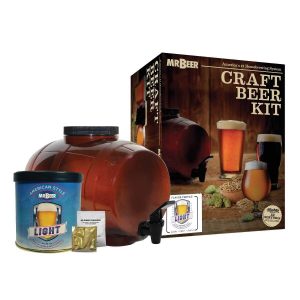
-
- Price: $39.95 – $59.95*
-
- What’s included:
-
-
-
- 2 gallon plastic fermenter with spigot
- Pre-hopped Liquid Malt Extract
- Yeast
- Sanitizer
- Instructions
- *Twelve (12) 740mL plastic bottles & caps
- *Bottle Labels
- *Carbonation Drops
-
-
-
- NOT Included:
-
-
- Funnel, Airlock, Thermometer
- Bottles (can upgrade to a bundle or source your own)
- Features & Benefits:
- ~30-45 minute brew day
- Yields 2 gallons of beer
- Streamlined equipment that doesn’t require siphons or transfers
-
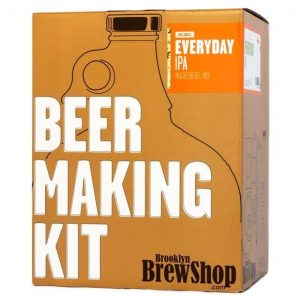
-
- Price: $45 – $48
- What’s included:
- 1 gallon glass carboy
- Racking cane & filter tip
- Plastic cap
- Transfer tubing
- Airlock
- Glass thermometer
- Sanitizer
- Beer Recipe Kit
- All-Grain Base malts
- Hops
- Yeast
- Sanitizer
- Special Ingredients (if applicable)
- NOT included:
- Funnel
- Hard Copy of Instructions (can be sourced online)
- Bottles (can upgrade to a bundle or source your own)
- Features & Benefits:
- ~3 hour brew day
- All-grain brewing process teaches you how to mash & sparge grains to create wort
- Variety of beer styles to choose from, including brewery collaborations with Stillwater and Mikkeller
